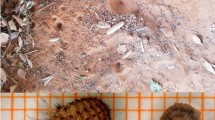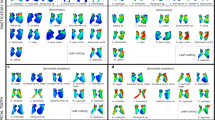Abstract
Evolutionary co-option of existing structures for new functions is a powerful yet understudied mechanism for generating novelty. Trap-jaw ants of the predatory genus Odontomachus are capable of some of the fastest self-propelled appendage movements ever recorded; their devastating strikes are not only used to disable and capture prey, but produce enough force to launch the ants into the air. We tested four Odontomachus species in a variety of behavioral contexts to examine if their mandibles have been co-opted for an escape mechanism through ballistic propulsion. We found that nest proximity makes no difference in interactions with prey, but that prey size has a strong influence on the suite of behaviors employed by the ants. In trials involving a potential threat (another trap-jaw ant species), vertical jumps were significantly more common in ants acting as intruders than in residents (i.e. a dangerous context), while horizontal jumps occurred at the same rate in both contexts. Additionally, horizontal jump trajectories were heavily influenced by the angle at which the substrate was struck and appear to be under little control by the ant. We conclude that while horizontal jumps may be accidental side-effects of strikes against hard surfaces, vertical escape jumps are likely intentional defensive behaviors that have been co-opted from the original prey-gathering and food-processing functions of Odontomachus jaws.




Similar content being viewed by others

References
Arthur W, Jowett T, Panchen A (1999) Segments, limbs, homology, and co-option. Evol Dev 1:74–76
Borgia G, Coleman SW (2000) Co-option of male courtship signals from aggressive display in bowerbirds. Proc R Soc Lond B Biol Sci 267:1735–1740
Borgmeier VT (1920) Zur Lebensweise von Odontomachus affinis Guerin. Z Dtsch Ve Wiss Kunst Sao Paulo 1:31–38
Brown WL, Wilson EO (1959) The evolution of the dacetine ants. Q Rev Biol 34:278–294
Carlin NF, Gladstein DS (1989) The ‘bouncer’ defense of Odontomachus ruginodis and other odontomachine ants (Hymenoptera: Formicidae). Psyche 96:1–19
Carroll SB (2005) Endless forms most beautiful: the new science of evo devo and the making of the animal kingdom. Norton, New York, p 350
Dejean A, Bashingwa EP (1985) La predation chez Odontomachus troglodytes Santschi (Formicidae-Ponerinae). Insectes Soc 32:23–42
Dejean A, Lachaud J-P (1991) Polyethism in the ponerine ant Odontomachus troglodytes: interaction of age and interindividual variability. Sociobiology 18:177–196
Dejean A, Suzzoni JP, Schatz B, Orivel J (2002) Territorial aggressiveness and predation: two possible origins of snapping in the ant Plectroctena minor. Comptes Rendus Biologies 325:819–825
De La Mora A, Perez-Lachaud G, Lachaud J-P (2008) Mandible strike: the lethal weapon of Odontomachus opaciventris against small prey. Behav Processes 78:64–75
Ehmer B, Hölldobler B (1995) Foraging behavior of Odontomachus bauri on Barro Colorado Island, Panama. Psyche 102:215–224
Fowler HG (1980) Populations, prey capture and sharing, and foraging of the Paraguayan ponerine Odontomachus chelifer Latreille. J Nat Hist 14:79–84
Grobecker DB, Pietsch TW (1979) High-speed cinematographic evidence for ultrafast feeding in antenariid anglerfishes. Science 205:1161–1162
Gronenberg W (1995a) The fast mandible strike in the trap-jaw ant Odontomachus. 1. Temporal properties and morphological characteristics. J Comp Physiol A Neuroethol Sens Neural Behav Physiol 176:391–398
Gronenberg W (1995b) The fast mandible strike in the trap-jaw ant Odontomachus. 2. Motor control. J Comp Physiol A Neuroethol Sens Neural Behav Physiol 176:399–408
Gronenberg W (1996) The trap-jaw mechanism in the dacetine ants Daceton armigerum and Strumigenys sp. J Exp Biol 199:2021–2033
Gronenberg W, Tautz J (1994) The sensory basis for the trap-jaw mechanism in the ant Odontomachus bauri. J Comp Physiol A Neuroethol Sens Neural Behav Physiol 174:49–60
Gronenberg W, Tautz J, Holldobler B (1993) Fast trap jaws and giant neurons in the ant Odontomachus. Science 262:561–563
Gronenberg W, Brandao CRF, Dietz BH, Just S (1998) Trap-jaws revisited: the mandible mechanism of the ant Acanthognathus. Physiol Entomol 23:227–240
Guerrette PA, Ginziger DG, Weber BHF, Gosline JM (1996) Silk properties determined by gland-specific expression of spider fibroin gene family. Science 272:112–115
Holland PWH, Garcia-Fernandez J, Williams NA, Sidow A (1994) Gene duplications and the origins of vertebrate development. Dev Suppl:125–133
Jacob F (1977) Evolution and tinkering. Science 196:1161–1166
Jaffé K, Marcuse M (1983) Nestmate recognition and territorial behaviour in the ant Odontomachus bauri Emery (Formicidae: Ponerinae). Insectes Soc 30:466–481
Just S, Gronenberg W (1999) The control of mandible movements in the ant Odontomachus. J Insect Physiol 45:231–240
Knaden M, Wehner R (2004) Path integration in desert ants controls aggressiveness. Science 305:60
Mallatt J (1997) Crossing a major morphological boundary: the origin of jaws in vertebrates. Zool Anal Complex Syst 100:128–140
Moffett MW (1985) Trap-jaw predation and other observations on two species of Myrmoteras (Hymenoptera: Formicidae). Insectes Sociaux 33:85–99
Patek SN, Korff WL, Caldwell RL (2004) Deadly strike mechanism of a mantis shrimp. Nature 428:819–820
Patek SN, Baio JE, Fisher BL, Suarez AV (2006) Multifunctionality and mechanical origins: ballistic jaw propulsion in trap-jaw ants. Proc Natl Acad Sci U S A 103:12787–12792
Plachetzki DC, Oakley TH (2007) Key transitions during the evolution of animal phototransduction: novelty, “tree-thinking,” co-option, and co-duplication. Integr Comp Biol 47:759–769
Powell S, Tschinkel WR (1999) Ritualized conflict in Odontomachus brunneus and the generation of interaction-based task allocation: a new organizational mechanism in ants. Anim Behav 58:965–972
Prum RO (2005) Evolution of the morphological innovations of feathers. J Exp Zool 304B:570–579
Spagna JC, Vakis AI, Schmidt C, Patek SN, Tsutsui N, Zhang X, Suarez AV (2008) Phylogeny, scaling, and the generation of extreme forces in trap-jaw ants. J Exp Biol 211:2358–2368
Suter RB (2003) Trichobothrial mediation of an aquatic escape response: directional jumps by the fishing spider, Dolomedes triton, foil frog attacks. J Insect Sci 3:29
True JR, Carroll SB (2002) Gene co-option in physiological and morphological evolution. Annu Rev Cell Dev Biol 18:53–80
Wheeler WM (1922) Observations of Gigantiops destructor Fabricius and other leaping ants. Biol Bull 42:185–201
Acknowledgements
The authors thank Brian Fisher of the California Academy of Sciences, Chris Smith of the University of Illinois, and Mark Deyrup of the Archbold Field Station for assistance collecting and maintaining ant colonies. We also thank Kevan Citta and Rebecca Schield for assistance with data collection. For permission to collect and import ants, we thank the Ministry of Environment and Energy (Permit 122-2004-OFAU) of Costa Rica, the Ministerio de Salud y Ambiente (Permit 20202/05) of Argentina, the Administracion de Parques Nacionales (Permit 002870-2) of Argentina, James Cook University, Australia for the loan of O. cephalotes specimens, and the United States Department of Agriculture (APHIS import permit 69963). This work was supported by a seed grant from the Beckman Institute for Advanced Science and Technology.
Author information
Authors and Affiliations
Corresponding author
Additional information
Communicated by J. Heinze
Rights and permissions
About this article
Cite this article
Spagna, J.C., Schelkopf, A., Carrillo, T. et al. Evidence of behavioral co-option from context-dependent variation in mandible use in trap-jaw ants (Odontomachus spp.). Naturwissenschaften 96, 243–250 (2009). https://doi.org/10.1007/s00114-008-0473-x
Received:
Revised:
Accepted:
Published:
Issue Date:
DOI: https://doi.org/10.1007/s00114-008-0473-x



